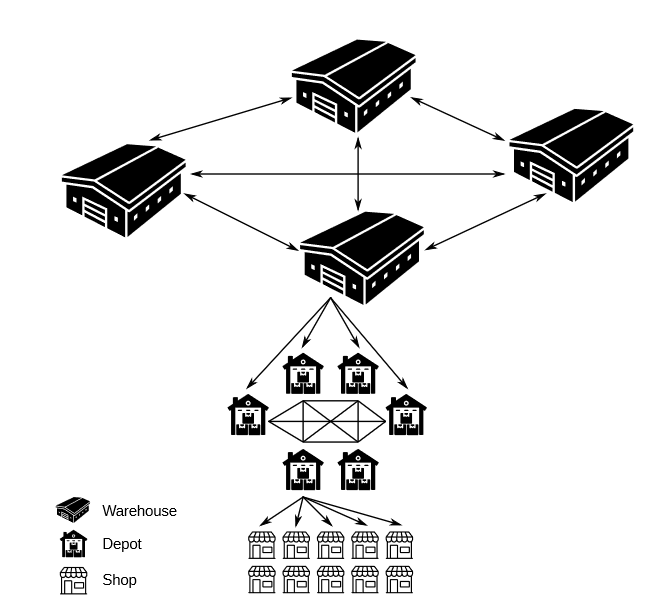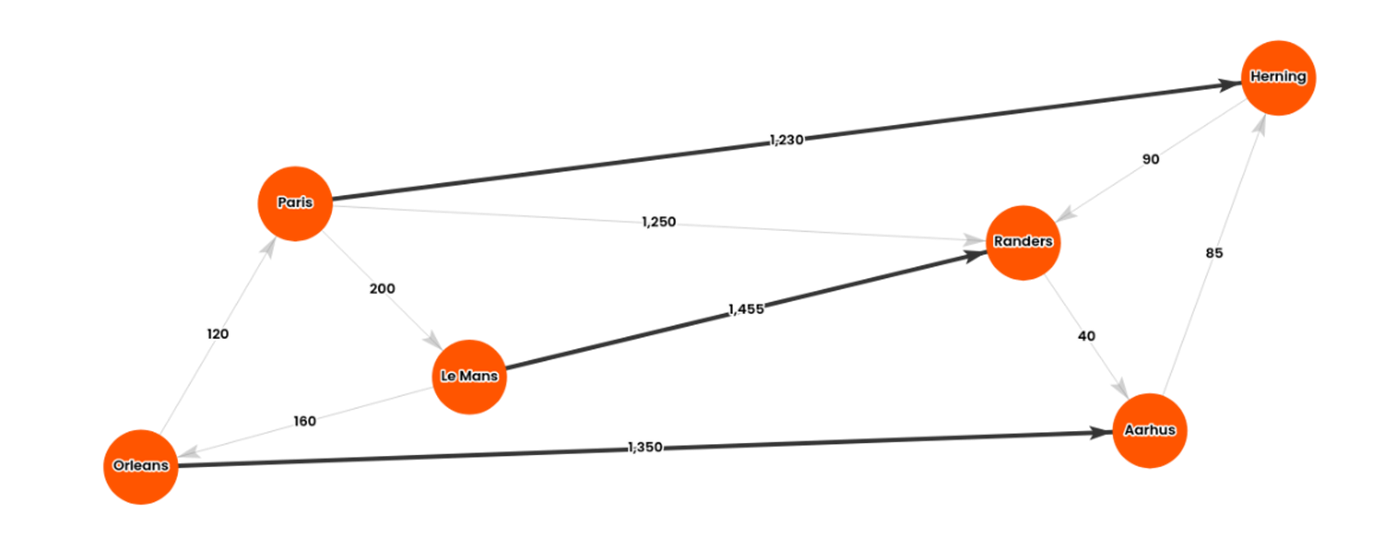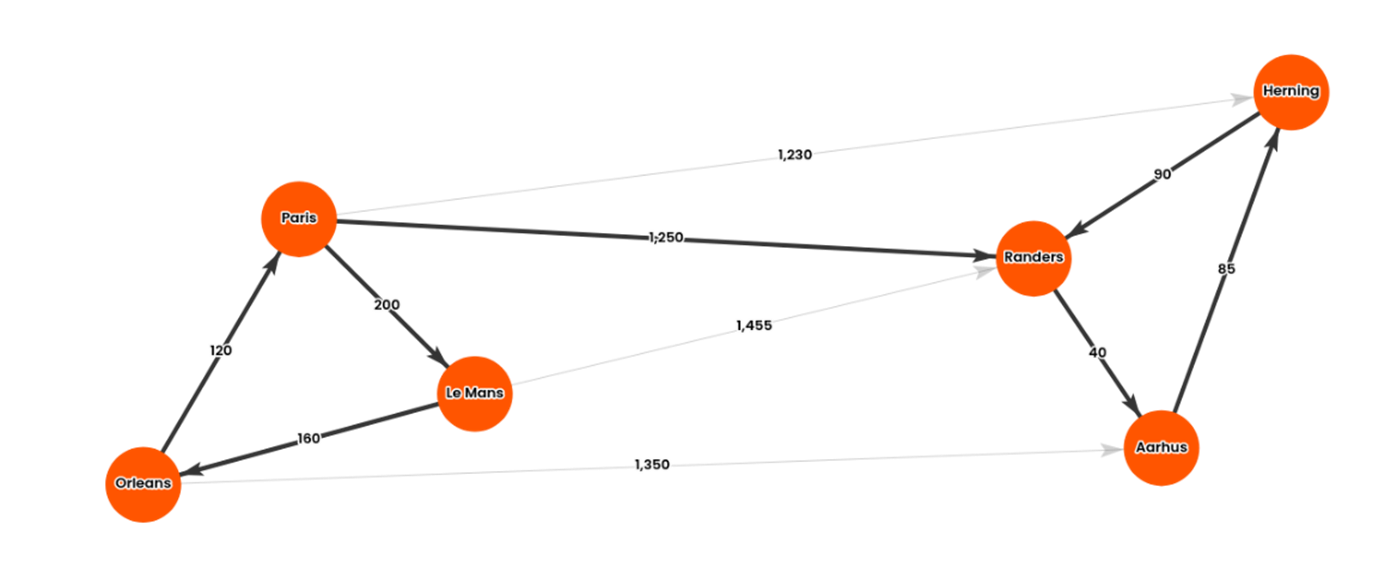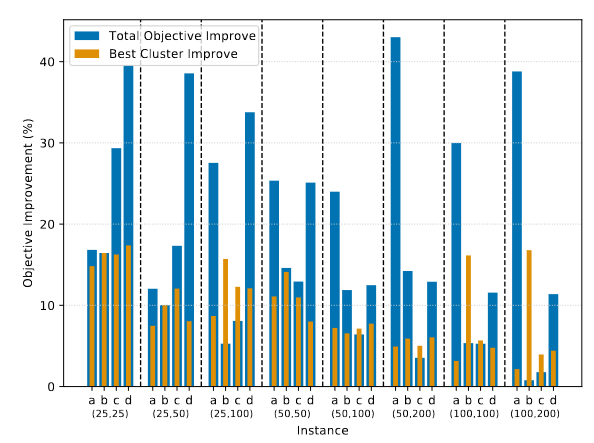29 August 2022

Jonas Christoffer Villumsen
European R&D Centre,
Hitachi Europe Ltd.

Junko Hosoda
Research & Development Group, Hitachi, Ltd.
Supply chains are often complex networks including many facilities such as warehouses, factories, depots, and shops interconnected by transport links via land, sea, and air. Commodities are transported across the network from production facilities to shops to based on customer demand. Connected facilities with similar characteristics are typically grouped into tiers with commodities flowing through each tier from higher-level tiers to lower-level tiers. Figure 1 illustrates the final three tiers of a potential supply chain network.

Figure 1. Final three tiers in a typical supply chain network
The transportation of commodities between warehouses within a tier of the supply chain network is traditionally performed using point-to-point deliveries with little or no opportunity for consolidation of commodities (as an example see Figure 2). This limits the flexibility of the supply chain operator and may yield lower efficiency of operations. If we introduce points of consolidation - that is, locations where commodities may be transferred between vehicles and aggregated – this adds additional flexibility to the inter-warehouse transportation problem, and allows for increased efficiency (see Figure 3 for an example).

Figure 2. Example with point-to-point deliveries.
Nodes represent warehouses, while link labels indicate distance in km (not to scale).

Figure 3. Example with consolidated deliveries which reduces number of long-distance deliveries.
Nodes represent warehouses, while link labels indicate distance in km (not to scale).
Previously, one of our partners constructed several warehouses for consolidation of commodities but relied on point-to-point deliveries between warehouses. This however proved inflexible and inefficient and prompted a change in operations to design an inter-warehouse transportation network that is adaptable to changes in demand. The warehouses will be re-designed so that they can be converted into intermediary consolidation locations based on a monthly review of demand forecasts. Our study develops the tools necessary to identify warehouse clusters and consolidation locations with respect to forecasted demand to improve the flexibility and efficiency of inter-warehouse transportation. In our study, we found that by consolidating commodities from warehouses located in proximity, the number of long-distance transport links can be reduced, and the efficiency of long-distance transport can be improved. For example, consider three commodities delivered within Europe from Le Mans to Randers, from Orleans to Aarhus, and from Paris to Herning, respectively. If point-to-point delivery is used, three vehicles – one for each commodity – are necessary (Figure 2). Each of the three vehicles must drive more than 1,000 km. If commodities are consolidated in Paris and delivered to Randers, only one vehicle must drive more than 1,000 km assuming that all commodities will fit in a single vehicle (Figure 3). One additional (smaller) vehicle is required to pick up commodities from Orleans and Le Mans and deliver to the consolidation point in Paris, which is less than 200 km, while another (smaller) vehicle delivers commodities from Randers to Aarhus and Herning, which again is less than 200 km. In this case, the delivery efficiency of consolidated delivery is higher than point-to-point delivery.
The issue to realise consolidated deliveries is to determine the delivery region of consolidated commodities, the location of consolidation warehouses, the transport schedule between regions, as well as the transport schedule within each region to achieve a high delivery efficiency. We proposed a method to improve the efficiency of inter-warehouse transportation by integrating the three problems:
These three problems are traditionally performed separately, sequentially, and with different time horizons. However, moving towards a dynamically optimised, flexible supply chain design, it is beneficial to solve the three problems in an integrated fashion.
From our study, we proposed an algorithm to solve the integrated problem of identifying consolidation warehouses, optimising transshipment between consolidation warehouses, and scheduling the pickup and delivery of commodities to and from the consolidation points. The algorithm is based on a multi-armed bandit approach and iterates between solving the three problems WCP, SNDP, and PDP, until convergence to a global solution. The approach is outlined in Figure 2. (Please, refer to our paper [1] which reports on the study for a more detailed description of the algorithm.)

Figure 4. Outline of solution algorithm
The approach was tested on 160 randomly generated instances of different sizes and characteristics. Based on these tests we have observed a significant improvement in the quality of the solution by applying the integrated approach. Figure 5 shows the average improvement to the objective cost function, which includes the inter-region delivery cost, intra-region delivery cost, and penalty cost for unsatisfied time constraints for 32 categories of instances (each of which contains five instances). Delivery costs include a fixed cost of using each vehicle and a variable cost related to the weight of delivered commodities. The blue bars indicate the total improvement relative to a sequential approach, where each of the problems is solved only once, while the orange bars indicate the improvement in objective function value assuming that the optimal number of consolidation points is known in advance. We can see that significant improvement was achieved for reducing the cost – in some cases by more than 40%.

Figure 5. Results for 160 randomly generated instances in 32 groups of varying size. The blue bars indicate average improvement in objective function relative to a sequential approach. Orange bars indicate average relative improvement in objective function value assuming that the optimal number of consolidation points is known in advance.
Improving flexibility and competitiveness by keeping cost and environmental emissions down, while being able to adapt to changes in demand, production capacity, and sudden ruptures in transport capability is critical in today’s complex supply chains. In our paper [1], we provide an integrated approach for optimising the inter-warehouse transportation problem considering consolidation of commodities and solving the warehouse clustering problem, the supply chain network design problem, and the pickup and delivery problem in an integrated way. We show that this leads to significant improvement in the cost as compared to a strictly sequential approach, which is traditionally employed.